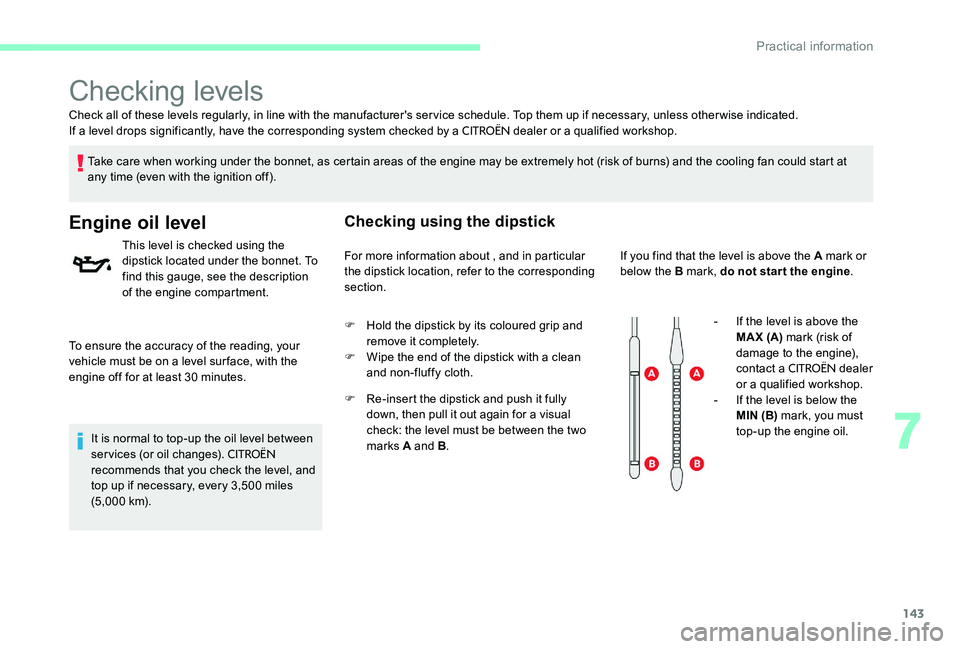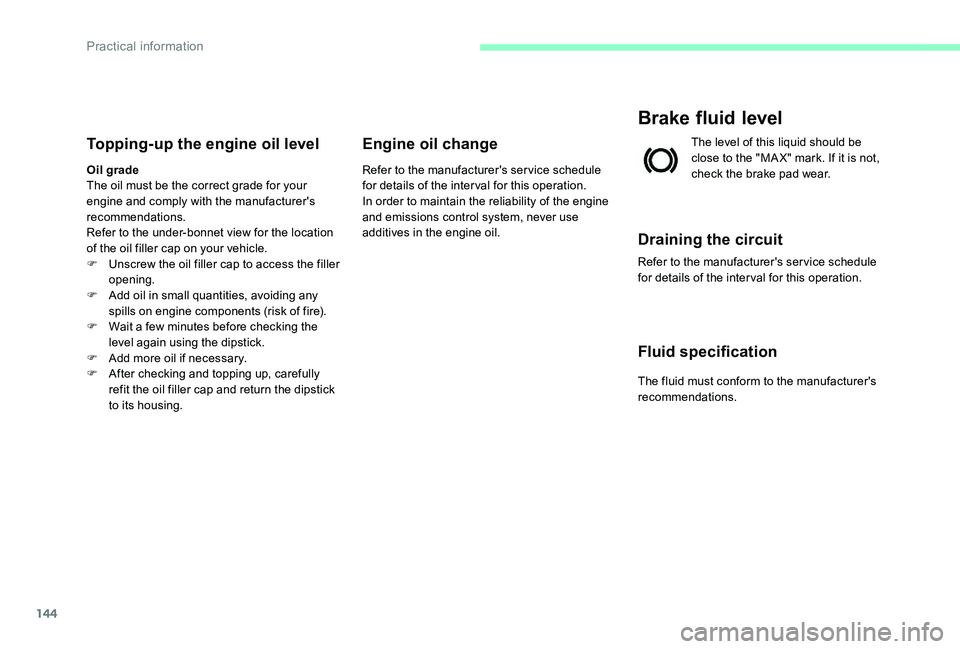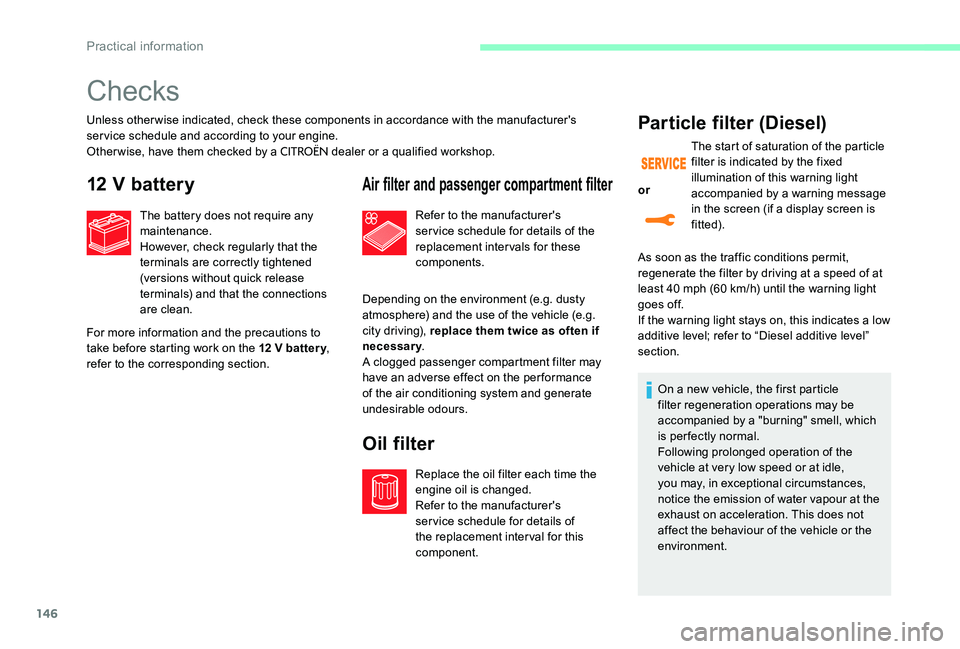check oil CITROEN C-ELYSÉE 2017 Handbook (in English)
[x] Cancel search | Manufacturer: CITROEN, Model Year: 2017, Model line: C-ELYSÉE, Model: CITROEN C-ELYSÉE 2017Pages: 306, PDF Size: 9.34 MB
Page 10 of 306

8
Maintenance - Technical data
7
Petrol weight
1
80
Diesel weight
1
81
8
Identification elements
1
83
Dimensions
1
82
1
Checking the levels
1
43 -145
-
oil
-
b
rake fluid
-
coolant
-
s
creenwash fluid
-
a
dditive (diesel with particle filter)
Checking the components
1
46-147
-
battery
-
a
ir/passenger compartment filter
-
o
il filter
-
p
article filter (diesel)
-
b
rake pads/discs
2
Running out of Diesel fuel
1
48
AdBlue
® and SCR
(Diesel BlueHDi) system 1 32-135
3
Battery
1
72-176
Load reduction, economy mode
1
37
4
Engine compartment fuses
1
67-171
5
Opening bonnet
1
41
Under bonnet layouts, petrol
1
42
Under bonnet layout, Diesel
1
42
Petrol engines
1
80
Diesel engine
1
81
6
Changing bulbs
1
61-166
-
front
-
rear
Over view
Page 12 of 306

10
Limit the causes of
excess consumption
Spread loads throughout the vehicle; place
the heaviest items in the bottom of the boot,
as close as possible to the rear seats.
Limit the loads carried in the vehicle and
reduce wind resistance (roof bars, roof rack,
bicycle carrier, trailer...). Preferably use a roof
box.
Remove roof bars and roof racks after use.
At the end of winter, remove snow tyres and
refit your summer tyres.
Observe the recommendations
on maintenance
Check the tyre pressures regularly, when cold,
referring to the label in the door aperture,
driver's side.
Carry out this check in particular:
-
b
efore a long journey,
-
a
t each change of season,
-
a
fter a long period out of use.
Don't forget the spare wheel and the tyres on
any trailer or caravan. Have your vehicle serviced regularly (engine
oil, oil filter, air filter, etc.) and observe the
schedule of operations recommended by the
manufacturer.
When filling the tank, do not continue after the
3
rd cut-off of the nozzle to avoid over flow.
At the wheel of your new vehicle, it is only
after the first 1,800 miles (3,000 kilometres)
that you will see the fuel consumption settle
down to a consistent average.
Eco-driving
Page 15 of 306

13
Warning / indicator lampStateCause Action / Observations
STOP Fixed, associated
with another warning
light. It is associated with the engine
oil pressure or the engine
coolant temperature. You must stop as soon as it is safe to do so.
Park, switch off the ignition and call a
CITROËN dealer
or qualified workshop.
Parking brake Continuous. The parking brake is applied or
not properly released. Release the parking brake to switch off the warning
light, keeping your foot on the brake pedal.
Observe the safety recommendations.
For more information on the Parking brake
, refer to
the corresponding section.
Brakes Fixed. The brake fluid level has
dropped significantly. You must stop as soon as it is safe to do so.
Top-up with brake fluid listed by
CITROËN.
If the problem persists, have the system checked by a
CITROËN dealer or a qualified workshop.
Fixed, associated
with the ABS warning
light. The electronic brake force
distribution (EBFD) system has
a fault. You must stop as soon as it is safe to do so.
Have it checked by a
CITROËN dealer or a qualified
workshop.
1
Instruments
Page 145 of 306

143
Check all of these levels regularly, in line with the manufacturer's service schedule. Top them up if necessary, unless other wise indicated.
If a level drops significantly, have the corresponding system checked by a CITROËN dealer or a qualified workshop.
Take care when working under the bonnet, as certain areas of the engine may be extremely hot (risk of burns) and the cooling fan could start at
any time (even with the ignition off).
Checking levels
Engine oil level
To ensure the accuracy of the reading, your
vehicle must be on a level sur face, with the
engine off for at least 30 minutes.
It is normal to top-up the oil level between
services (or oil changes).
CITROËN
recommends that you check the level, and
top up if necessary, every 3,500 miles
(5,000 km). This level is checked using the
dipstick located under the bonnet. To
find this gauge, see the description
of the engine compartment.
Checking using the dipstick
For more information about , and in particular
the dipstick location, refer to the corresponding
section.
F
H
old the dipstick by its coloured grip and
remove it completely.
F
W
ipe the end of the dipstick with a clean
and non-fluffy cloth.
F
R
e-insert the dipstick and push it fully
down, then pull it out again for a visual
check: the level must be between the two
marks A and B . If you find that the level is above the A mark or
below the B mark, do not star t the engine
.
-
I
f the level is above the
MA X (A) mark (risk of
damage to the engine),
contact a
CITROËN dealer
or a qualified workshop.
-
I
f the level is below the
MIN (B) mark, you must
top-up the engine oil.
7
Practical information
Page 146 of 306

144
Topping-up the engine oil level
Oil grade
The oil must be the correct grade for your
engine and comply with the manufacturer's
recommendations.
Refer to the under-bonnet view for the location
of the oil filler cap on your vehicle.
F
U
nscrew the oil filler cap to access the filler
opening.
F
A
dd oil in small quantities, avoiding any
spills on engine components (risk of fire).
F
W
ait a few minutes before checking the
level again using the dipstick.
F
A
dd more oil if necessary.
F
A
fter checking and topping up, carefully
refit the oil filler cap and return the dipstick
to its housing.
Engine oil change
Refer to the manufacturer's service schedule
for details of the interval for this operation.
In order to maintain the reliability of the engine
and emissions control system, never use
additives in the engine oil.
Brake fluid level
The level of this liquid should be
close to the "MA X" mark. If it is not,
check the brake pad wear.
Draining the circuit
Refer to the manufacturer's service schedule
for details of the interval for this operation.
Fluid specification
The fluid must conform to the manufacturer's
recommendations.
Practical information
Page 147 of 306

145
Coolant level
The check and top-up must only be done with
the engine cold.
A low coolant level presents a risk of serious
damage to your engine.
The coolant level should be close to the "MA X"
mark but should never exceed it.
If the level is close to or below the "MIN" mark,
it is essential to top-up.
When the engine is hot, the temperature of the
coolant is regulated by the fan.
In addition, as the cooling system is
pressurised, wait at least one hour after
switching off the engine before carrying out any
work.
To avoid the risk of scalding when you need to
top-up in an emergency, place a cloth around
the cap and unscrew the cap by two turns to
allow the pressure to drop.
Once the pressure has dropped, remove the
cap and top-up the level.Check the coolant level regularly.
It is normal to top up the fluid
between two services.
Fluid specification
The fluid must conform to the manufacturer's
recommendations.
The cooling fan may star t after
switching off the engine: take care
with articles and clothing that might be
caught by the fan blades.
Screenwash fluid level
Top up the level when necessary.
Fluid specification
For optimum cleaning and to avoid freezing,
this fluid must not be topped up or replaced
with plain water.
In wintry conditions, it is recommended that you
use an ethyl alcohol or methanol based fluid.
Diesel additive level (Diesel
engine with particle filter)
A low additive level is indicated by illumination
of the service warning light, accompanied by an
audible warning and a message in the screen
(if a display screen is fitted).
To p p i n g u p
This additive must be topped-up by a CITROËN
dealer or a qualified workshop without delay.
Used products
Avoid prolonged contact of used oil or
fluids with the skin.
Most of these fluids are harmful to health
or indeed very corrosive.
Do not discard used oil or fluids into
sewers or onto the ground.
Take used oil to a
CITROËN dealer or
a qualified workshop and dispose of in
the containers made available for this
purpose.
7
Practical information
Page 148 of 306

146
Checks
Unless otherwise indicated, check these components in accordance with the manufacturer's
service schedule and according to your engine.
Other wise, have them checked by a
CITROËN dealer or a qualified workshop.
12 V battery
For more information and the precautions to
take before starting work on the 12 V batter y,
refer to the corresponding section. The battery does not require any
maintenance.
However, check regularly that the
terminals are correctly tightened
(versions without quick release
terminals) and that the connections
are clean.
Air filter and passenger compartment filter
Depending on the environment (e.g. dusty
atmosphere) and the use of the vehicle (e.g.
city driving), replace them twice as often if
necessary
.
A clogged passenger compartment filter may
have an adverse effect on the per formance
of the air conditioning system and generate
undesirable odours. Refer to the manufacturer's
service schedule for details of the
replacement intervals for these
components.
Oil filter
Replace the oil filter each time the
engine oil is changed.
Refer to the manufacturer's
service schedule for details of
the replacement interval for this
component.
Particle filter (Diesel)
As soon as the traffic conditions permit,
regenerate the filter by driving at a speed of at
least 40 mph (60 km/h) until the warning light
goes off.
If the warning light stays on, this indicates a low
additive level; refer to “Diesel additive level”
section. or
The start of saturation of the particle
filter is indicated by the fixed
illumination of this warning light
accompanied by a warning message
in the screen (if a display screen is
fitted).
On a new vehicle, the first particle
filter regeneration operations may be
accompanied by a "burning" smell, which
is per fectly normal.
Following prolonged operation of the
vehicle at very low speed or at idle,
you may, in exceptional circumstances,
notice the emission of water vapour at the
exhaust on acceleration. This does not
affect the behaviour of the vehicle or the
environment.
Practical information
Page 149 of 306

147
Manual gearbox
The gearbox does not require any
maintenance (no oil change).
Refer to the manufacturer's service
schedule for the checking interval
for this component.
Electronic gearbox
The gearbox does not require any
maintenance (no oil change).
Refer to the manufacturer's service schedule
for the checking interval for this component.
Automatic gearbox
The gearbox does not require any
maintenance (no oil change).
Refer to the manufacturer's service
schedule for the checking interval
for this component.
Brake pads
Brake wear depends on the style
of driving, particularly in the case
of vehicles used in town, over short
distances. It may be necessary to
have the condition of the brakes
checked, even between vehicle
services.
Unless there is a leak in the circuit, a drop in
the brake fluid level indicates that the brake
pads are worn.
Brake disc wear
For information on checking brake
disc wear, contact a CITROËN dealer
or a qualified workshop.
Parking brake
If excessive travel or a loss of
effectiveness of this system is
noticed, the parking brake must
be checked, even between two
services.
Checking this system must be done by a
CITROËN dealer or a qualified workshop.
Only use products recommended by
CITROËN or products of equivalent quality
and specification.
In order to optimise the operation of units
as important as those in the braking
system,
CITROËN selects and offers very
specific products.
After washing the vehicle, dampness, or
in wintry conditions, ice can form on the
brake discs and pads: braking efficiency
may be reduced. Make light brake
applications to dry and defrost the brakes.
7
Practical information
Page 153 of 306

151
F Check that the compressor switch is at the "O " position.
F
U
ncoil fully the electric cable, stowed under
the compressor.
If after around 5 to 7 minutes the pressure
of 2 bars is not attained, this indicates
that the tyre is not repairable; contact a
CITROËN dealer or a qualified workshop
for assistance. F
P
lace the switch in the "
O" position.
F
R
emove the kit.
F
C
onnect the compressor's electrical
connector to the vehicle's 12 V socket.
F
S
witch on the ignition.
F
D
rive immediately for approximately
three miles (five kilometres), at reduced
speed (between 15 and 35 mph (20 and
60 km/h)), to plug the puncture.
F
S
top to check the repair and the tyre
pressure using the kit.
F
S
tart the compressor by turning the switch
to the " l" position until the pressure of the
tyre reaches 2.0 bars. The sealant product
is injected under pressure into the tyre; do
not disconnect the hose of the valve during
this operation (risk of blowback).
8
In the event of a breakdown
Page 154 of 306

152
Checking / adjusting tyre pressures
You can also use the compressor,
without injecting sealant, to check and if
necessary adjust the tyre pressures
F
R
emove the valve cap from the tyre and
place it in a clean area.
F
U
ncoil the pipe stowed under the
compressor.
F
S
crew the pipe onto the valve and tighten
f i r m l y. F
C
heck that the compressor switch is at the
" O " position.
F
U
ncoil fully the electric cable, stowed under
the compressor.
F
C
onnect the compressor's electrical
connector to the vehicle's 12 V socket.
F
S
witch on the ignition.
Take care, the sealant product is harmful
if swallowed and causes irritation to the
eyes.
Keep this product out of the reach of
children.
The use-by date is marked on the bottle.
After use, do not discard the bottle by the
roadside, take it to a
CITROËN dealer or an
authorised waste disposal site.
Don't forget to obtain a new bottle of
sealant, available from a
CITROËN dealer
or a qualified workshop.
In the event of a breakdown